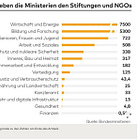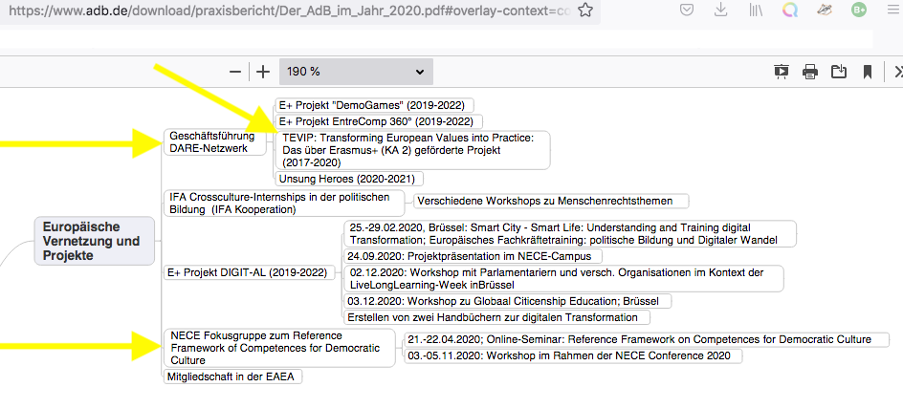Germany Gate, Part Two: Down the Rabbit-Hole of GO/NGOs and Their Ties
Strangeley enough, although hardly surprising at this point in time, many GO/NGOs are intimately connected via shared funders, board members, and stated aims
Editorial prelim: this is a long-form essay about the nefarious role of GO/NGOs we recently explored in some detail:
This piece comes in three instalments, with this posting being the second part. For the first part, please see here:
All non-English translations, emphases, and commentary are mine.
Ukrainian and Russian Exile NGOs in Norway—and their Funders
In the beginning, I promised to take you down a very particular rabbit-hole. So, without much further ado, here’s how all of the above—Norway’s 17 May festivities, the Azov formations, the Kyiv government, and the shenanigans of Western governments and intelligence services—intersect.
To set this up properly, recourse is made to a piece that appeared in Bergens Tidende on 15 Feb. 2022. It reveals several issues that warrant attention:
The Ukrainians’ Association in Bergen holds that Norwegians don’t understand that Ukraine has been at war for eight years: ‘People die every day’, says Volodymir Novosad.
Quite curious, isn’t it, that this article appeared literally the day before the Ukrainian army and paramilitary began firing into the Donbass across the line of contact, which, as is known, precipitated the Russian ‘special military operation’. This information derives from the OSCE’s Special Monitoring Mission to Ukraine, as per their report dated 21 Feb. 2022, which you can download directly here (the below graphs are from pp. 2-3, respectively):
Note further that more a whooping 81.4% of all conflict-related civilian casualties in Ukraine from 2018 up to 31 Dec. 2021 occurred on the territory held by the Donbass ‘separatists’. This means that 4 out of 5 of these casualties were most likely due to fire originating from territory held by the Kyiv government, according the UN High Commissioner for Human Rights (data on p. 2).
Back to the above-cited Bergens Tidende piece from 15 Feb. 2022, which cites Hanna Veits (28), a native of Lugansk in the Donbass who fled to Bergen where she’s now a musical student (she plays the violin; as above, my translation and emphases):
‘For eight years, no one thought that Russia would invade, but now we know better and think one must be prepared for everything. Suitcases are packed and she works hard to get travel documents for the cat. The hope is that if something happens, she can quickly apply for asylum in Norway’, says Veits.
Then there’s this quote by Mr. Novosad:
Russian President Vladimir Putin said on Tuesday that he did not want war. He has also stated that Russia has started a partial withdrawal.
‘It is difficult to believe what he says. He speaks with many tongues’, says Volodymir Novosad (52).
Mind you, this piece appeared on 15 Feb. 2022, i.e., one day before the Ukrainian side began to ratchet up the shelling of the Donbass.
It’s perhaps not surprising at this point—that the clear anti-Russian bias was present at the very least11 days before the beginning of the Russian operations in eastern Ukraine.
Equally unsurprising is the fact that there was a ‘spontaneous’ anti-Russian demonstration outside the embassy in Oslo, which was reported by Norwegian state broadcaster NRK on 24 Feb. 2022 (the first day of the Russian ‘special military operation’) as early as 9:53 a.m. Norwegian time:
Ill.: as appeared in the news-ticker of Norwegian state broadcaster NRK; the highlighted two sentences translate into: ‘This is one of many protests in Norwegian cities today. The organisation “SmåRådina: For Democracy in Russia” organises a protest outside the Russian embassy in Oslo at 11 a.m. on Thursday’.
What a coincidence to find Mr. Novosad (see here for the Ukrainians’ Association website) and the reference to anti-war protests in many Norwegian cities, alright (see here for an English-language news item), but what I found even more interesting is that ‘organisation SmåRådina’ (Little Motherland): who are they?
Here is a link here to SmåRådina’s website, ‘the place for all those concerned about Russia and the development of democracy in Russia’.
SmåRådina is a ‘pro-democracy in Russia’ NGO based in Norway (see here for contact details) that also run the website stopvoina.no (stop the war), but if you are looking for, say, SmåRådina’s funding, there is little to no information on the website.
They do have a big project—entitled #freenavalny—that provides clues about where they may get part of their funding: from other western ‘NGOs’, governments, and/or intelligence services.
And then there is Eugenia Khoroltseva, a member of SmåRådina’s steering board, who piqued my interest. That link, though, has since been taken down; do click here for a rather fawning piece in the New York Times that features her. What a coincidence.
For whatever reason, Ms. Khoroltseva, who was—is (?)—a member of not only SmåRodina (mentioned favourably in the NYT), but she is also a project leader with a focus on Russia of the Norwegian Human Rights Academy (Mennesketsrettighetsakademiet), based in Oslo.
As regards their funding, the Human Rights Academy’s Annual Report says a lot—or it does not:
In 2021, [Human Rights Academy’s] activities have been funded through project support from the City of Oslo, Sparebankstiftelsen DNB, the Directorate of Integration and Diversity (IMDI), the DAM Foundation, the Nordic Council of Ministers, EEA/Norway Grants, the Lennox Foundation, and others. Income also comes from fees from lectures, workshops, and counselling, as well as membership fees. After a challenging year in 2018, when [the Human Rights Academy] received significantly less funding for its activities in Russia than in previous years, we have had a good development. The outlook for 2022 and beyond is positive.
Curiously enough, ‘others’ are mentioned, in addition to the EEA/Norway Grants—and do not the latter’s shiny, if devoid-of-details website.
Back to Eugenia Khoroltseva, though, lest one gets lost in the netherworld of NGO financing.
DARE to Know
Apart from her engagement on part of the Oslo-based Norwegian Human Rights Academy, Ms. Khoroltseva is also a member of the steering board of DARE, the network for ‘Democracy and Human Rights Education in Europe’.
Ill.: Ms. Khoroltseva is standing next to fellow DARE board members Matia Losego, Eugenia Khoroltseva, Frank Elbers, Georg Pirker, Zuzka Schreiberova, Agnese Balode og Marco Oberosler (from left to right; source).
DARE is yet another NGO that does not disclose its funding sources. When you click on the link entitled, ‘about the DARE network’, the following information can be obtained:
The Democracy and Human Rights Education in Europe (DARE) Network is a Europe-wide network of primarily NGOs, academic institutions and training providers devoted to promote active democratic citizenship and human rights through formal education, non-formal and informal education, and life-long learning.
What a wonderful thing, right? Although DARE does not disclose its funding, they at least have a sub-page entitled ‘partners’, which provide some insight into their backers. Their support derives from, among others, the Council of Europe, the EU Agency for Fundamental Rights [which does not have anything to say about ‘Assange’], the Lifelong Learning Platform, and—NECE.
What, then, would that acronym stand for? Well, I am glad you asked. NECE stands for the Networking European Citizenship Education, yet another ‘NGO’ that, much like the proverbial Russian matryoshka dolls, are found once one starts browsing these ‘about us’ sites.
All Roads Lead to the EU and—the German Government, all via more ‘NGOs’
At least, I found that DARE and NECE are supported by the Arbeitskreis deutscher Bildungsstätten e.V., the Association of German Educational Organizations, or AdB (homepage here). AdB is
an association made up of approximately 170 continuing education centres throughout Germany with various profiles—youth education centres, adult education centres, academies, Europe centres, educational centres of party-related foundations and international encounter centres. As a whole these independent educational organisations represent a wide spectrum of various training offers as well as organisational structures…
We aim to preserve and promote civic education as an important element of democracy. Democracy is not only a form of government but needs to be experienced and promulgated in the daily lives of citizens. Civic education is a training field for democracy. Through their training offers, the member organisations of the association strive to motivate and enable citizens to recognize the relationship between political framework conditions and their own lives, play an active role in public affairs and participate in the making of society and political processes. The member organisations see themselves as places of encounter between people of different cultures, demographic groups and worlds. As a specialised organisation of civic education we foster an exchange of information and experience, training and a joint representation of interests in the area of civic education. We actively contribute to specialised discussions on civic education. We advocate a European Educational Network for Human Rights and Democracy and commit ourselves to the realisation of equal opportunities between men and women in all our fields of work (my emphases, but their agit-prop)
NECE, again, which is connected to DARE, which is connected to the Oslo-based Human Rights Academy via shared personnel, specifically Ms. Khoroltseva—who also works for (with) the anti-Putin activist group SmåRodina whose members work with the Ukrainian Association in Bergen. A small world, indeed.
On the Arbeitskreis deutscher Bildungsstätten e.V.’s website, there is a quite extensive, if not really concise, ‘mindmap’ that shows the partners they work with:
Again, we can easily spot both DARE and NECE—but also yet another institution called ‘TEVIP’, which I have not encountered before.
TEVIP stands for ‘Translating European Values into Practice’ and it is an organisation with a very weird web presence (see here). It offers ‘Education on (European) Values)’ by which is meant one may obtain from them
concepts and materials for educational activities to trainers, multipliers, and teachers on the topic of values. The aim is to enable and promote an open debate on this sensitive issue, and particularly on its European dimension.
Curiously, they are very open about their ‘target group’, which are defined as
multipliers working with young people (aged under 25) who have had no or only little contact with Europe-related topics before. Most activities have been developed for use in non-formal education but may also be used by teachers in formal education. They can also be used by international youth groups at European youth events, camps etc. (emphasis in the original)
TEVIP’s funding comes via the Erasmus+ program, i.e., by EU contributions that flow into educational and research projects, at least from 2017 through 2020. Its partners include (Source):
If one wishes to get in contact, there are two ‘Contact People’: Charlotte Wiesenthal of Berlin, Germany, and Ramón Martinez of the DARE Network.
The imprint, however, indicates that TEVIP’s homepage ‘is run by planpolitik Simon Raiser and Björn Warkalla’.
And that, dear readers, is where we stop for today—there’s a lot to take in, and we’ll explore, as far as it is possible, the illustrious connections and ties of planpolitik in tomorrow’s third part.








Watch, and don't say you have not been warned.
Sunday livestream 2 March 2025 - https://www.youtube.com/watch?v=b6D2vVBD89U
Follow also the links in the video description.
How to Stop Schizo God Emperor Trump - YouTube - https://www.youtube.com/watch?v=BSKlmJNv6Rc